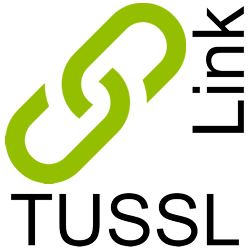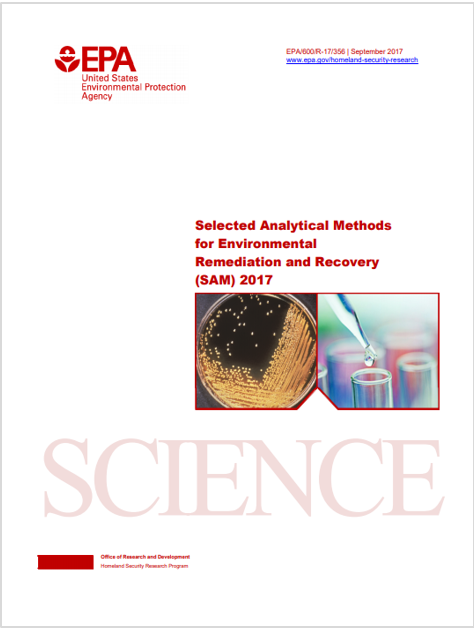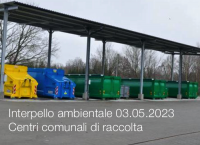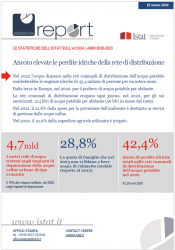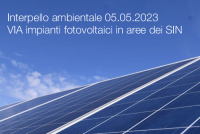Selected Analytical Methods for Environmental Remediation and Recovery (SAM) 2017 - EPA
| ID 7555 | | Visite: 3925 | Documenti Ambiente Enti | Permalink: https://www.certifico.com/id/7555 |
Selected Analytical Methods for Environmental Remediation and Recovery (SAM) 2017
(Metodi analitici per la bonifica e il ripristino ambientale)
After the terrorist attacks of September 11, 2001 and the anthrax attacks in the fall of 2001, federal and state personnel provided response, recovery and remediation under trying circumstances, including unprecedented demand on laboratory capabilities to analyze environmental samples. In reviewing these events, the Environmental Protection Agency (EPA) identified several areas to enhance the resiliency of the nation following homeland security-related incidents resulting in intentional or accidental contamination. The need to improve the nation’s laboratory capacity and capability to analyze environmental samples following such incidents (i.e., chemical, biological and/or radiological [CBR] contamination) was one of the most important areas identified. This need has proven to be an on-going concern as the nation faces continued contamination incidents, such as the environmental contamination introduced by the 2014 microcystins contamination of drinking water in Toledo, Ohio; the 2013 ricin letter incident in Washington, D.C.; and the 2011 Fukushima power plant accident which threatened contamination of the western coast of the United States.
To address this need, EPA formed the Homeland Security Laboratory Capacity Work Group to identify and implement opportunities for near-term improvements and to develop recommendations for addressing longer-term laboratory issues. The EPA Homeland Security Laboratory Capacity Work Group consisted of representatives from the EPA’s Office of Research and Development (ORD), Office of Air and Radiation (OAR), Office of Water (OW), Office of Land and Emergency Management (OLEM, formerly Office of Solid Waste and Emergency Management), Office of Environmental Information, Office of Chemical Safety and Pollution Prevention, and several EPA regional offices.
A critical area identified by the Homeland Security Laboratory Capacity Work Group was the need for a list of selected analytical methods to be used by all laboratories when analyzing contamination incident samples and, in particular, when analysis of many samples is required over a short period of time. EPA’s Environmental Response Laboratory Network (ERLN) is a national network of laboratories that can be accessed as needed to support responses to large-scale environmental contamination incidents by providing analytical capabilities and data of consistent quality in a systematic, coordinated response. This network includes the Water Laboratory Alliance (WLA), which can be accessed specifically for responses pertaining to the nation’s water sector.1 Using the same selected methods should reduce confusion, permit sharing of sample load between laboratories, improve data comparability, and simplify the task of outsourcing analytical support to the commercial laboratory sector. Use of such methods would also improve follow-up activities, including validating results, evaluating data and making decisions. To this end, work group members formed an Analytical Methods Subteam to address homeland security methods issues.
The Analytical Methods Subteam recognized that widely different analytical methods are required for various phases of environmental sample analyses in support of homeland security preparedness and response:
1) ongoing surveillance and monitoring;
2) response and rapid screening for determining whether an incident has occurred;
3) preliminary site characterizations to determine the extent and type of contamination; and
4) confirmatory laboratory analyses to plan, implement, and evaluate the effectiveness of site remediation.
Figure 1-1 represents these analytical phases.
EPA’s Selected Analytical Methods for Environmental Remediation and Recovery (SAM)2 provides information for analytical methods to be applied during the “Site Remediation” phase. Methods have been selected to support activities related to site assessment (including preliminary, qualitative analyses to characterize the extent of contamination), site cleanup (to evaluate the efficacy of remediation efforts), and site clearance (releasing a site, including water and wastewater systems, for its intended use) decisions. In support of this document, EPA periodically assembles methods experts from within EPA, as well as other federal, state and local agencies; and public utilities, to review and update SAM. Workgroup members revise the methods listed or select new methods as appropriate, determine method tier classifications, provide input into special considerations, and add analytes of interest as needed. Analytes are included based on selection criteria that address the needs and priorities of EPA as well as other federal agencies (e.g., environmental persistence, half lives, availability, and toxicity). The sample types listed are specific to each technical section and have been determined by technical work groups to be a concern during site remediation. Work groups identify a single method or method group per analyte/sample type to ensure a consistent analytical approach across multiple laboratories when analyzing environmental samples.
Figure 1-1. Environmental Evaluation Analytical Process Roadmap for Homeland Security Incidents
(1) Information regarding EPA’s Environmental Response Laboratory Network is available at:
https://www.epa.gov/emergency-response/environmental-response-laboratory-network
Information regarding the Water Laboratory Alliance (WLA) is available at:
https://www.epa.gov/waterlabnetwork/learn-about-water-laboratory-alliance
(2) Formerly EPA’s Standardized Analytical Methods for Environmental Restoration Following Homeland Security Events. SAM and its methods are available at: https://www.epa.gov/homeland-security-research/sam
EPA 2017
Collegati
| Descrizione | Livello | Dimensione | Downloads | |
|---|---|---|---|---|
| Selected Analytical Methods EPA 2017.PDF EPA 2017 |
4532 kB | 6 |






























